My sideblog for all things D&D and TTRPG. Mostly dumping things here for reference, but maybe I’ll post about campaigns I’m in again. Who knows!
Don't wanna be here? Send us removal request.
Text
One of the most common ways you preserve pork without refrigeration is keeping it in really salty water. This makes the pork borderline inedible because it’s so salty. What you don’t see in medieval fantasy is people soaking their meat in water for a bit before they cook it.
That’s also a reason to boil your meat though. Like yeah meat tastes better if you sear it first but sometimes you’ve gotta get that salt out.
6K notes
·
View notes
Text
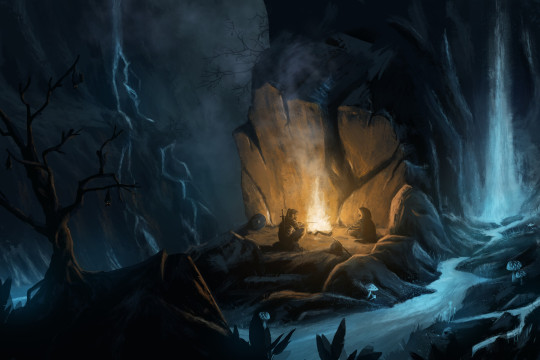
See You Back at the Bonfire: Checkpoint Based Resurrection in D&D
Artsource
Between doing a writeup on soulsborne inspired campaign settings and another on the oldschool/newschool disparity between challenge and story, I got to thinking about death and its place in gamified narratives. Darksouls was the obvious influence, but I couldn't help but think of Dungeon Meshi, World of Warcraft, and supergiant's Hades.
Back in the day death was common in d&d, the challenges were unforgiving and the characters were expendable as they were simple. High level might as well have meant "high scoring", as the rewards for overcoming deathtraps and monsters with save-or-die abilities were directly translated into character progression. Death in this instance amounted to a combo breaker, being sent back to square 1 in a roguelike to do it all again. Over time though we started getting attached to our avatars, especially those of us who played primarily for story, leading characters to become too emotionally or mechanically complicated to feed into the blender.
This leaves the modern DM in a bit of a lurch: death by mooks or misadventure denies a satisfying (or heartwrenching) endpoint to the story you're collectively telling with your players. Look no further than Critical Role, where there are a small number of plot-meaningful deaths ( Vexhalia in the Tomb, Mollymauk to the Iron Shepards) and then a much larger tally of obligatory moments where someone fails one too many death saves and requires the use of a spell slot. The DM is forced to play with gloves on much of the time, holding back from creating real challenges because they don't want to kill any of their characters at the wrong time.
What I’d like to propose is that when it comes to challenge vs story we can have the best of both worlds if we’re a little more freehanded when it comes to resurrection. It'll take some tinkering and it won't fit for every story, but as a baseline assumption to the d&d formula, I think it could be quite useful.
How It'd Work: If someone dies before their appointed time , their body can be brought to a local temple to have the gift of life restored to them. Temples of their own deity are thought to work best, but lifegiving deities like Pelor or Illmater are known to be quite freehanded when it comes to raising the dead, and even small countryside shrines are known to work in a pinch. The resurrection may not work if the body is damaged, desecrated, or incomplete, though sometimes the spirit is simply incapable or unwilling to return.
For adventuresome types, this means that if you bite it while exploring the wilderness or some dank ruin you best hope your companions like you enough to drag your corpse back to the nearest altar. Likewise hope that you've kept on good terms with that god. If your entire party wipes, there's a chance for a good samaritan (or enterprising corpse picker) to help you out, though they'll usually help themselves to what's in your pockets in the meantime.
Some temples also sell rare tokens or burnable offerings that can transform any mundane campfire into a one-use resurrection altar, though the expendable nature of these charms mean they are in high demand.
Behind the scenes: what we've done here is turn character death from a plot derailer into a plot generator. Whenever someone in your party dies, it's your excuse to introduce new npcs, questhooks, and worldbuilding. Hades uses this trick to soften the blow of defeat with story progression, and DunMeshi uses it to build out the setting.
We can likewise take a point of inspiration from soulsborne games which use the player's desire to find a safety granting bonfire to spur exploration; What's the first thing the party are going to when hitting a new settlement after renting a room at the inn? Check out the neighbourhood temples to see which of the local gods is sympathetic to them. Same thing with seeking out the shrine nearest to the dungeon entrance before descending lower to face greater threats, which has them engaging with the location's story while discovering a minor questhook to endear themselves to the shrine god.
This is also to say nothing of all the fun adventure-fodder surrounding the mechanics including all the delightful "came back wrong" possibilities.
Finally let's talk about some gameplay assumptions: It's a tricky art building d&d encounters, especially since 5e play tends to default towards having fewer encounters per day, meaning a greater importance on these encounters being more challenging. This is a problem that I and many other DMs have wrestled with; finding the right degree of challenge for the encounter to be meanacing and meaningful, but without going so far as to risk an unexpected character death derailing my game. There's only so many permadeaths a player (and a story) can endure, to say nothing of the narrative killing tpk, which can scrap months of investment and storytelling potential.
Videogame designers figured out this balancing act of narrative and risk a long time ago, bumping characters back to a checkpoint when the player is overwhelmed by a challenge. The Soulsborne franchise built it's reputation on this "If at first you don't succeed, die, die again" mentality, which let them build the challenging ( read: engaging) gameplay the series is known for. Games like Hades go so far as to make this reset a centeral point of furthering the plot, allowing the narrative to expand with each stumble along the player's insurmountable climb.
By allowing characters to be easily revived, we end up with the best of both worlds when it comes to narrative vs. difficulty. The encounters we build can be more challenging in the moment if we know we won't accidently end a campaign if the dice get mean. This also makes players more likely to make big swings and try for optional content knowing the campaign less likely to end if they fuck up.
While some people might take umbrage with the idea of making resurrection commonplace, D&D already allows for characters to be revived though in-game mechanics at the cost of cleric spells and diamond dust. The devs figured out pretty early that even in a game centred around frequent violent clashes, it sucks to have a character you're invested in die unexpectedly, and it's better for the health of the game/narrative to be able to get those characters back at a cost. The problem is that these resurrection mechanics are siloed off to mid/high level characters, when it's the low level adventurers who are most fragile and thus most in need of an in-game safety net.
Secondly, look at the Soulsborne series as the inspiration for this post: part of the reason players are able to "Git Gud" is because the fast respawns allow for players to get right back into the action after making a fatal error, allowing for a "die, die again" playstyle focused on persistence and adaptation. This likewise allows developers to develop gameplay scenarios that are properly intimidating:
175 notes
·
View notes
Text
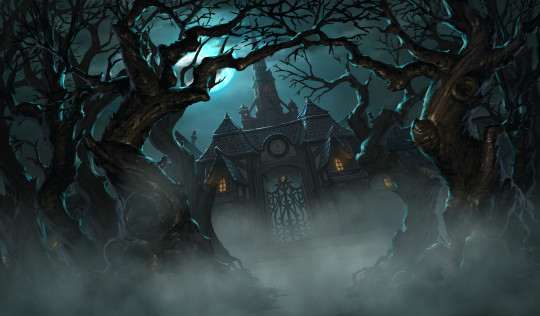
Tableskills: Creating Dread
I've often had a lot of problems telling scary stories at my table, whether it be in d&d or other horror focused games. I personally don't get scared easily, especially around "traditionally horrifying" things so it's hard for me to recreate that experience in others. Likewise, you can't just port horror movie iconography into tabletop and expect it to evoke genuine fear: I've already spoken of being bored out of my mind during the zombie apocalypse, and my few trips into ravenloft have all been filled with similar levels of limp and derivative grimdark.
It took me a long time (and a lot of video essays about films I'd never watched) to realize that in terms of an experience fear is a lot like a joke, in that it requires multiple steps of setup and payoff. Dread is that setup, it's the rising tension in a scene that makes the revelation worth it, the slow and literal rising of a rollercoaster before the drop. It's way easier to inspire dread in your party than it is to scare them apropos of nothing, which has the added flexibility of letting you choose just the right time to deliver the frights.
TLDR: You start with one of the basic human fears (guide to that below) to emotionally prime your players and introduce it to your party in a initially non-threataning manor. Then you introduce a more severe version of it in a way that has stakes but is not overwhelmingly scary just yet. You wait until they're neck deep in this second scenario before throwing in some kind of twist that forces them to confront their discomfort head on.
More advice (and spoilers for The Magnus Archives) below the cut.
Before we go any farther it's vitally important that you learn your party's limits and triggers before a game begins. A lot of ttrpg content can be downright horrifying without even trying to be, so it's critical you know how everyone in your party is going to react to something before you go into it. Whether or not you're running an actual horror game or just wanting to add some tension to an otherwise heroic romp, you and your group need to be on the same page about this, and discuss safety systems from session 0 onwards.
The Fundamental Fears: It may seem a bit basic but one of the greatest tools to help me understand different aspects of horror was the taxonomy invented by Jonathan Sims of The Magnus Archives podcast. He breaks down fear into different thematic and emotional through lines, each given a snappy name and iconography that's so memorable that I often joke it's the queer-horror version of pokemon types or hogwarts houses. If we start with a basic understanding of WHY people find things scary we learn just what dials we need turn in order to build dread in our players.
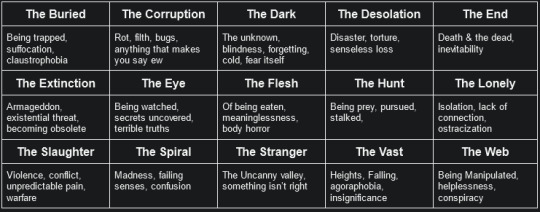
Implementation: Each of these examples is like a colour we can paint a scene or encounter with, flavouring it just so to tickle a particular, primal part of our party's brains. You don't have to do much, just something along the lines of "the upcoming cave tunnel is getting a little too close for comfort" or "the all-too thin walkway creaks under your weight ", or "what you don't see is the movement at the edge of the room". Once the seed is planted your party's' minds will do most of the work: humans are social, pattern seeking creatures, and the hint of danger to one member of the group will lay the groundwork of fear in all the rest.
The trick here is not to over commit, which is the mistake most ttrpgs make with horror: actually showing the monster, putting the party into a dangerous situation, that’s the finisher, the punchline of the joke. It’s also a release valve on all the pressure you’ve been hard at work building.
There’s nothing all that scary about fighting a level-appropriate number of skeletons, but forcing your party to creep through a series of dark, cobweb infested catacombs with the THREAT of being attacked by undead? That’s going to have them climbing the walls.
Let narration and bad dice rolls be your main tools here, driving home the discomfort, the risk, the looming threat.
Surprise: Now that you’ve got your party marinating in dread, what you want to do to really scare them is to throw a curve ball. Go back to that list and find another fear which either compliments or contrasts the original one you set up, and have it lurking juuuust out of reach ready to pop up at a moment of perfect tension like a jack in the box. The party is climbing down a slick interior of an underdark cavern, bottom nowhere in sight? They expect to to fall, but what they couldn't possibly expect is for a giant arm to reach out of the darkness and pull one of them down. Have the party figured out that there's a shapeshifter that's infiltrated the rebel meeting and is killing their allies? They suspect suspicion and lies but what they don't expect is for the rebel base to suddenly be on FIRE forcing them to run.
My expert advice is to lightly tease this second threat LONG before you introduce the initial scare. Your players will think you're a genius for doing what amounts to a little extra work, and curse themselves for not paying more attention.
Restraint: Less is more when it comes to scares, as if you do this trick too often your players are going to be inured to it. Try to do it maybe once an adventure, or dungeon level. Scares hit so much harder when the party isn't expecting them. If you're specifically playing in a "horror" game, it's a good idea to introduce a few false scares, or make multiple encounters part of the same bait and switch scare tactic: If we're going into the filthy gross sewer with mould and rot and rats and the like, you'll get more punch if the final challenge isn't corruption based, but is instead some new threat that we could have never prepared for.
Art
356 notes
·
View notes
Text
This is I think, my best prep tip as a DM:
When the players are about to visit a new town, pre-generate several NPCs who fit the demographics of the town, but don't give them jobs. Your town is Mostly human, with a number of halflings and gnomes? Make a list that's mostly humans with some halflings and gnomes mixed in, with names that match the vibe you're going for and maybe the barest description + a quirk of some sort.
So the list would look something like this:
Ophelia Bracegurdle, older Halfling woman who laughs a lot
Norabecka Johnson, a young human woman who seems tired
Geraldofinio Babblecock Nimsy, gnome gentleman who takes pains to maintain a fabulous mustache
Etc.
Then, when the players are like, "Can I go to the blacksmith?" You look at your list of NPCs and the one at the top is Ophelia Bracegurdle. She's your blacksmith now. Then they want to go to the tavern, where Norabecka is the innkeeper and Geraldofinio is a patron having a drink at the bar. He's using a straw so he doesn't mess up his mustache.
If they had gone to the inn first, Ophelia would have been the innkeeper with Norabecka as the patron, and then Geraldofinio should have been a blacksmith with some sort of mustache guard to keep the sparks off.
Making the list ahead of time doesn't take much time, and you can often re-use the people you never got to at the next town.
Your world will seem vibrant and interesting and like you have everything planned out.
Have fun!
24K notes
·
View notes
Text
The real reason your sapient dragon character needs a "rider":
Dragons on the wing are vulnerable to being mobbed by smaller, more agile flyers, particularly in your large rear blind spot, like a bird of prey being mobbed by crows. Having a human armed with a long spear perched on your back helps to dissuade anyone from getting any funny ideas.
Breath weapons are impressive enough on the ground, but in flight they're really only good for strafing stationary targets; trying to use your breath weapon in an aerial dogfight is a good way to get fire up your nose. A real fight calls for sterner measures – and, concomitantly, a crew to aim and reload the cannons.
In today's competitive world, it's not enough to devour a flock of sheep and call it a day if you want to keep your edge. You're accompanied at all times by a qualified personal alchemist tasked with carefully regulating your internal furnace to ensure peak performance, and sometimes you even listen to them.
No dragon of any quality would be caught dead without their valet. It's not as though you can announce your numerous long-winded titles yourself when introductions are called for, can you? You suppose next you'll be expected to pick up the spoils of your conquests yourself, like a common brigand. Perish the thought!
56K notes
·
View notes
Photo





Vengeful Spirit. May need some tweaks. Creature that is born from a pact with a devil after someone kills them. Maybe some innocent npc a player decided to kill for fun? They continue returning from the grave until specific conditions are met, getting stronger each time.
1K notes
·
View notes
Photo
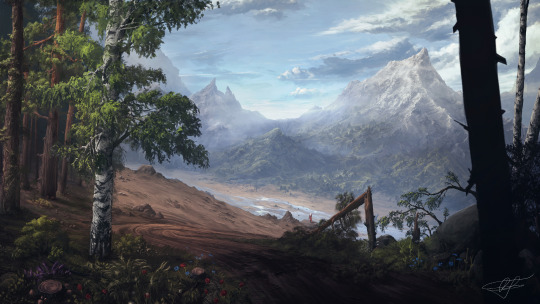
Drafting the Adventure: Wilderness and Exploration
For a game with exploration as one of it’s “core pillars”, d&d is kinda shit at producing gameplay conducive to actually making players feel like they’re exploring.If you play it by the book travelling from point A to B often feels like a slog, and a good number of groups are completely justified in skipping it entirely and just getting to the good bits. I think the problem largely stems from trying to cram the hexcrawl/westmarches style of gameplay from d&d’s heyday into the central gameplay loop when really it should be the focus of very particular kinds of adventure. Think of a big exploration adventure the same way you’d run a heist or murder mystery, usually a one off unless you’re running a specialized campaign.
With that said, the base rules for hanging out in the wilderness are IMO in massive need of an overhaul, so we might as well overhaul those along with setting up a good guidelines for running an exploration based adventure. Before we dive under the hood and get into all those storybuilding steps and mechanics, lets look at how my system works from the players’ perspective:
In lieu of any urgent quests or fantastic job offers, a group of adventurers decide they’re going to explore the wilderness outside their settlement and look for some opportunities.
One character chats up the locals, hearing rumours of what might be going on outside the walls. The second does some research on the area and finds a few trustworthy maps to copy. Another checks the local bountyboard for outlaws and monsters it might pay to hunt down.
The party sets out, and the DM asks the party which player wants to be the group’s surveyor: keeping a list of what places the party has visited, what options are available to them, and what might need a bit more exploration.
The DM has divided the area they’re exploring into zones with names like “The forbidden peaks” or “ The merry meadows” which gives each area a strong geographic identity and makes it easy for the party to remember and gives them an idea of what to expect.
Every time the party walks into a new zone, they learn the area’s name, and how many “points of interest” are in that region. A point of interest could be anything from a unique environmental detail to the lead in to an encounter to a monster lair to the entrance to a whole dungeon. The surveyor keeps track of these points of interest, making space to write in whatever details they think are relevant.
Likewise upon entering into a new zone, the party are made aware of “landmarks” striking points of interest that are obvious to the naked eye and don’t need to be searched for. Because this group prepared before they left, they’ll likely have learned of a few more points of interest in the region based off the information they gathered.
When the party have fully explored a point of interest, the DM tells the surveyor to check off the name of that location, indicating that it’s safe and that the party can turn their attention elsewhere
When deciding where to go next, the party has two options: Set out for a specific area (one they know about or have visited before) or to Wander, poking around till they find a location they didn’t know about previously. The DM may ask for checks while the party is traveling based on the difficulty of reaching the point of interest or the particulars of the zone they’re travelling through.
Because the DM has been upfront with how many points of interest are in the zone, the party have an understandable goal of filling in a list and checking off each location. This feels like actual exploration because the party is actually making the decision of where to go and how deep to search, combining those key elements of choice and discovery that make setting out into the unknown so rewarding.
Below the cut I’m going to go into detail about how to BUILD an exploration adventure, everything from designing goals to fit your narrative needs to choosing what kind of points of interest to seed into the world .
Keep reading
341 notes
·
View notes
Photo
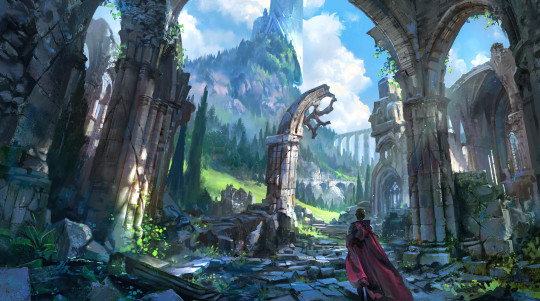
Drafting the Adventure: Dungeons Without Walls
I love the idea of dungeons, but there was a significant portion of my life as a DM where they didn’t feature in my games. While Pathfinder and 5e provided a great framework for character building and tactical skirmishes that I could build story on top of, neither was really great when it came time to detour into a dungeon. My players tended to get confused when we headed out to plunder the local ruin or cave system, spending a lot more time figuring out where they were and what they should be doing than actually doing anything.
The problem as it turned out was limited information. I had a picture of the dungeon in my head/notes but I couldn’t telepathically infer that to the party, and the back and forth questions where they tried to orient themselves within my mental labyrinth ate up a lot of session time prevented us from attaining that snappy pace that every table needs to keep the players invested.
Recently though I had an epiphany about overhauling exploration in d&d, and wrote up a whole post detailing how you could build and run wilderness adventures the same way you could a heist or a murder mystery. Because I was already writing a series about dungeon design it didn’t take long for me to realize that this exploration overhaul was 100% applicable, and could solve a lot of the delay and confusion my players usually faced on their next trip underground. Spoilers: it worked amazingly.
The key to this overhaul was giving my players enough information to see the dungeon as a sort of abstract checklist, and then giving them the power to investigate and check things off that list in whatever order they wished, when they enter a new level of the dungeon they get a new checklist to fill out which still keeps that sense of exploration. Folk love checking things off lists, and I as a dungeonmaster love it when players engage with the content I’ve spent so much energy creating even if it’s only poking their head in the door to realize they want to run away as fast as possible. Likewise, designing the dungeon this way let me tackle much larger concepts without having to sweat the details of filling up every little room as I would have to in map-centric design.
Keep reading
623 notes
·
View notes
Text
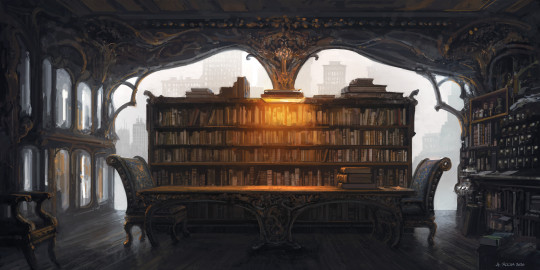
Homebrew Mechanic: Meaningful Research
Being careful about when you deliver information to your party is one of the most difficult challenges a dungeonmaster may face, a balancing act that we constantly have to tweak as it affects the pacing of our campaigns.
That said, unlike a novel or movie or videogame where the writers can carefully mete out exposition at just the right time, we dungeonmasters have to deal with the fact that at any time (though usually not without prompting) our players are going to want answers about what's ACTUALLY going on, and they're going to take steps to find out.
To that end I'm going to offer up a few solutions to a problem I've seen pop up time and time again, where the heroes have gone to all the trouble to get themselves into a great repository of knowledge and end up rolling what seems like endless knowledge checks to find out what they probably already know. This has been largely inspired by my own experience but may have been influenced by watching what felt like several episodes worth of the critical role gang hitting the books and getting nothing in return.
I've got a whole write up on loredumps, and the best way to dripfeed information to the party, but this post is specifically for the point where a party has gained access to a supposed repository of lore and are then left twiddling their thumbs while the dm decides how much of the metaplot they're going to parcel out.
When the party gets to the library you need to ask yourself: Is the information there to be found?
No, I don't want them to know yet: Welcome them into the library and then save everyone some time by saying that after a few days of searching it’s become obvious the answers they seek aren’t here. Most vitally, you then either need to give them a new lead on where the information might be found, or present the development of another plot thread (new or old) so they can jump on something else without losing momentum.
No, I want them to have to work for it: your players have suddenly given you a free “insert plothook here” opportunity. Send them in whichever direction you like, so long as they have to overcome great challenge to get there. This is technically just kicking the can down the road, but you can use that time to have important plot/character beats happen.
Yes, but I don’t want to give away the whole picture just yet: The great thing about libraries is that they’re full of books, which are written by people, who are famously bad at keeping their facts straight. Today we live in a world of objective or at least peer reviewed information but the facts in any texts your party are going to stumble across are going to be distorted by bias. This gives you the chance to give them the awnsers they want mixed in with a bunch of red herrings and misdirections. ( See the section below for ideas)
Yes, they just need to dig for it: This is the option to pick if you're willing to give your party information upfront while at the same time making it SEEM like they're overcoming the odds . Consider having an encounter, or using my minigame system to represent their efforts at looking for needles in the lithographic haystack. Failure at this system results in one of the previous two options ( mixed information, or the need to go elsewhere), where as success gets them the info dump they so clearly crave.
The Art of obscuring knowledge AKA Plato’s allegory of the cave, but in reverse
One of the handiest tools in learning to deliver the right information at the right time is a sort of “slow release exposition” where you wrap a fragment lore the party vitally needs to know in a coating of irrelevant information, which forces them to conjecture on possibilities and draw their own conclusions. Once they have two or more pieces on the same subject they can begin to compare and contrast, forming an understanding that is merely the shadow of the truth but strong enough to operate off of.
As someone who majored in history let me share some of my favourite ways I’ve had to dig for information, in the hopes that you’ll be able to use it to function your players.
A highly personal record in the relevant information is interpreted through a personal lens to the point where they can only see the information in question
Important information cameos in the background of an unrelated historical account
The information can only be inferred from dry as hell accounts or census information. Cross reference with accounts of major historical events to get a better picture, but everything we need to know has been flattened into datapoints useful to the bureaucracy and needs to be re-extrapolated.
The original work was lost, and we only have this work alluding to it. Bonus points if the existent work is notably parodying the original, or is an attempt to discredit it.
Part of a larger chain of correspondence, referring to something the writers both experienced first hand and so had no reason to describe in detail.
The storage medium (scroll, tablet, arcane data crystal) is damaged in some way, leading to only bits of information being known.
Original witnesses Didn’t have the words to describe the thing or events in question and so used references from their own environment and culture. Alternatively, they had specific words but those have been bastardized by rough translations.
Tremendously based towards a historical figure/ideology/religion to the point that all facts in the piece are questionable. Bonus points if its part of a treatise on an observably untrue fact IE the flatness of earth
491 notes
·
View notes
Note
I’m looking for advice on playing NPCs. Stuff like how to drop hints naturally. How to make sure you’re NPCs only know and give what they should.
If you have any tips on organizing/keeping track of thoughts for different NPCs it would be appreciated.
To me there’s two different problems at work here, requiring two different skills to be sharpened.
1) Most NPCs don’t actually have their own thoughts, and are just vessels the narrative takes while communicating what information the players need to know. While you might give the important ones motivations and backstory to color their expression, they’re still masks you as the DM use in your role as storyteller to direct the plot in different ways.
Say you’ve got an adventure involving a particular ghost-haunted ruin you want the players to explore. What you need is a particular “story beat” to get the party where you need them to go, but this beat can take innumerable forms before your party decides to either bite on the right adventure hook or abandon it for another storyline they become more interested in. It can start as a rumor overheard in a tavern, then into a request for esoteric materials by an enchanter, finally a plea from a wealthy town elder to rescue their loved one. You don’t need to keep track of who “knows” the beat, only keep it in circulation among your other ideas until it’s needed.
2) When and how to dole out information to your party, including deciding how many hoops they need to jump through and when to get it.
I like to separate “hidden” information in my campaigns into three distinct categories:
A, Specialized knowledge: The kind of thing not everyone would know, necessitating the party seek out an expert. ( Ask around and have an encounter with an NPC, gain entrance to the archives etc)
B, Privileged information: Things other people DON’T want you to know, requiring the party to make specialized contacts, or slip past the people who guard said information .
C, Forgotten Lore: Information that is flat out a mystery, requiring the party to unravel conspiracies or go on full out adventures to gain access to.
When I make an adventure, generally the ways to avoid obstacles and get one’s bearings is only rank A, only an encounter with a single NPC away from being solved, where as true motivations and unseen factors are rank B. Information involving major story events is relegated to rank C.
Here’s the trick, when the party progresses the story, all that information slips down one rank: That which is hidden is discovered by those in the know, who can drop hints about it while the party is seeking them out for more relevant knowledge, where as that which was previously valuable information becomes common gossip.
Say there’s a murder plot going on that you want your party to be involved in after this campaign arc. It starts as forgotten lore, something the party stumbles on only if they happen to find a secret treasure trove of information, and then only as a hint. Later, as the party get closer to the murderplot, important npcs begin to know something about it, perhaps asking the party to check in on it in exchange for what they know. If the party blithely ignores the plot, it’ll eventually become common gossip, something that NPCs can’t help but blab about for the party to overhear.
Hope that helps! Knowing just how to mete out information in a story is a difficult process to master, but if you use this as a guide, I think you’ll find it’s easier to keep your forshadowing orderly.
476 notes
·
View notes
Text

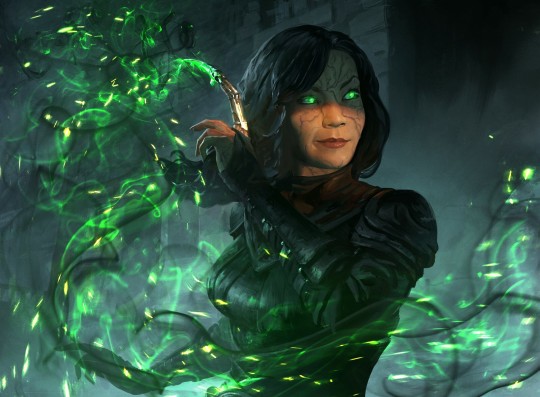
Villain: The Cult of the Wyrm Eternal
Any adventurer, alchemist, or awestruck child can tell you that there is power in the body of a dragon, and like all sources of power it’s only a mater of time before someone comes along to try to capitalize on it.
Enter the Cult of the Wyrm Eternal, which emerges from long buried vaults to dissect the bodies of dragonkind like flesh eating beetles. The cult originated from a time beyond remembering following the teachings of a profane text known as the Har'Khon Libram, which survives into the modern day as a sort of how-to manual for those seeking forbidden knowledge allowing them to revive the cult’s practices and discover its caches of lost power.
It’s in this manner that the cult has survived millennia and numerous purges at the hands of heroes, holy orders, and oligarchs: With each iteration caching away knowledge and resources for acolytes they will never meet.
Hooks:
A prominent dragonborn hero and ally of the party disappears, leaving behind few clues and a mystery to solve. Lacking a true dragon to carve up for ingredients the cult abducted the dragonborn and plans on sacrificing them after a gauntlet of strange rituals intended to suffuse their flesh with power. Its a race against the clock for the party to find their friend before there’s nothing left of them but a grisly scattering of magical items bound for the cult’s armoury.
The local warlord has a new pet, a young dragon provided to him by the cult in exchange for his protection and material support. Tales of him riding out to wreak destruction from its back send shivers of terror through the populace. What a surprise then when the party encounter it in the wild, rampaging aimlessly after slipping her bonds. Brainwashed by cult doctrine the parry find themselves negotiating with a creature with the drives of a caged tiger, the volatility of an abused teenager, and the destructive potential of an artillery battery. Talking her down will be as difficult as diffusing a bomb, but they might just come away with important information or even a new ally should they help her evade recapture.
Using knowledge purloined from the mysteries of the mother hydra herself a cell of the Wyrm Eternal has been working on a ritual to create a true dragon, experimenting with drakes, basilisks and other reptilian monsters, filling the wilderness with bounty worthy monsters that will inevitably bring the party crashing into their lair.
Keep reading
279 notes
·
View notes
Text


Dungeon: To Split the Mountain Wide
Renowned for it’s beauty and magical reactivity, Thaliasite is a valuable mineral said to spring up where the tears of a sky goddess soak into the earth. When deposits are found, they’re quickly mined to exhaustion.
Taking a gamble on of one of these near abandoned claims, a somewhat reckless alchemist has attempted to promote the growth of new crystal through an experimental process involving the channelling of elemental energies and a bit of bastardized geomancy which miraculously resulted in the growth of new crystals and the reopening of the mine.
Some weeks later however and it appears the process has worked too well as the slow initial recovery has given way to explosive new growth; splitting the mountain wide open and trapping several crews of workers in the depths of the mine. The party has been called in after rescue attempts were halted by rogue elementals, as well as attacks by grell from the nearby wastes drawn in by the arcane energies.
Adventure Hooks:
Need a quick starter for a badlands campaign? Have the party be made up of miners/locals from the nearby settlement who’s livelihood depends on the reopened mine. No better team building exercise then rescuing innocents from a magically and structurally unstable cave system liable to cave in/explode at any moment.
This literal explosion of valuable material is going to have far reaching consequences, turning the little mining village into a boomtown over the next few months. This will bring all kinds of fortuneseekers, outlaws, and wandering mages out of the woodwork, to say nothing of the more otherworldly entities that will blow in on the wind.
While you could chalk the disaster up to the usual unreliability of alchemical experimentation, a party that digs around a little deeper and keeps a wary eye out may discover a conspiracy by the mineral combine that once owned the depleted mine. The ability to produce Thaliasite could be an economic gamechanger, and the combine is not above engineering a little accident if it means not only reclaiming their former property but also buying out the disgraced alchemist’s formulas. If the party finds them out, the combine might just be willing to cut them in for a percentage, maybe make them overseers in their newly revitalized enterprise.
One of the miners the party ends up rescuing is a woman half conscious after getting caught in the shrapnel from the Thaliasite’s explosive growth. After some weeks of recovery she rises from her sickbed and begins after asking the party. Apparently having shards of divinely attuned crystal stuck in her greymatter has gotten her in touch with the goddess, who uses her impromptu oracle to tell the party of a trial awaiting them in the near future.
Art 1
Art 2
219 notes
·
View notes
Text
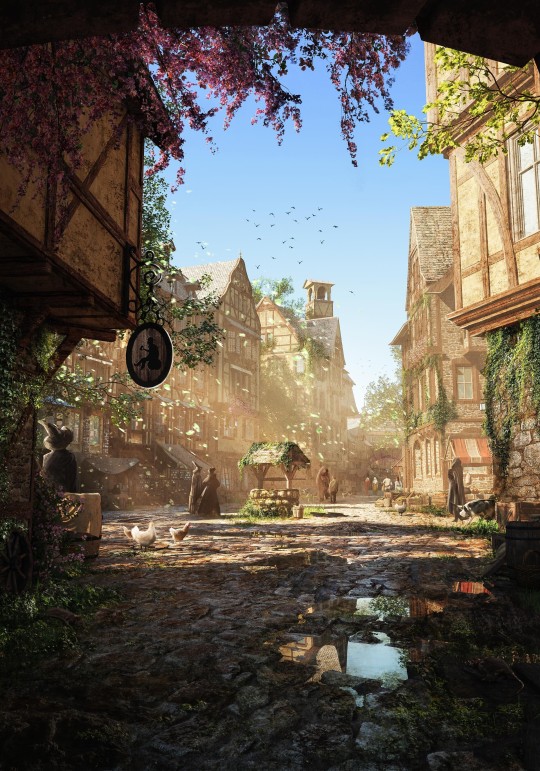
Adventure: Along the Kobold Street
Folk in Eldriton have been complaining about the muddy streets for over a generation, ever since their humble settlement grew from Eldrit village into a proper town. Traffic and merchant wagons churn the streets to mud even days after the rain, and the party notably have to slog through it to reach the inn on their first night.
Imagine everyone's surprise when folk awaken to discover a fresh swath of new cobbles along the town's main thoroughfare, appearing as if my magic in the dead of night. Some are wary but others are perplexedly elated, and the general mood is only further confused when it's discovered that the mayor's manor has been stripped down to it's wooden skeleton while he slept inside it.
Adventure Hooks:
Garbed in only his night shirt and clinging to a third story support beam, the mayor hollers at onlookers, alternating between demands for rescue and threats thrown at those carrying off his furniture and possessions, which have been neatly laid in the street for all to see. The frame of the disassembled manor creeks ominously, threatening collapse, and intercession by the party will likely earn them a significant reward if they don't bring the whole structure down on themselves. Or they could nick some valuables before the guards arrive and make a run for it.
The culprits in this perplexing case turn out to be warren 568, a collective of kobolds who've been moving into the region over the past couple months after their underdark tunnels brought them close enough to the surface to hit sunlight. They've proven themselves to be fine enough neighbours buying up provisions and trading tin with the local craftsmen, but there's an inevitable clash of cultures going on here. The kobolds don't get town people, why their leaders are allowed not to pull their weight and why an inefficiency like the muddy roads was allowed to persist. Then a couple of weeks back a few of their proquirers got to chatting with some market people and they overheard the rumour that the mayor never got around to seeing the roads paved because he was too busy building out his impressive home. "Ah" say the kobolds to themselves, already working out the logistics "we're good neighbours, let us fix that for you."
Days later, an old warehouses collapse in the night and tiny tools are found amid the rubble. The rumormill turns and folk start to whisper that the kobolds are intent on taring down all their houses in their mad act of "generosity". As it turns out, this is a ploy by a few of the local materials merchants to oust the kobolds for undercutting them. They hope to turn the unrest over the manor into active distrust.
Obviously aggrieved, the mayor wants the kobolds gone, and is willing to offer the party a tidy reward to infiltrate their mine and collapse some of the tunnels, bodycount be damned. If they keep to their principles and abstain from this bloodmoney they'll eventually be called in by the local reeve, apparently the mayor found bigger idiots with less scruples and she wants the party to find them before they instigate a massacre.
If the worse comes to pass and the mine collapses, the party may find themselves trapped in the underadark with some very distraught kobolds and no obvious way back to the surface.
Finally, if you're running with a new group of players or starting a fresh campaign consider using Eldriton as your "first town", a stopoff after the tutorial dungeon where the heroes were perhaps sent on a mission from the reeve so they can know her ahead of time. This adventure is pretty low stakes but offers a lot of opportunities for the group to decide who they are, be it opportunistic thieves, armature detectives, callous sellswords, or agents of order.
Artsource
280 notes
·
View notes
Photo
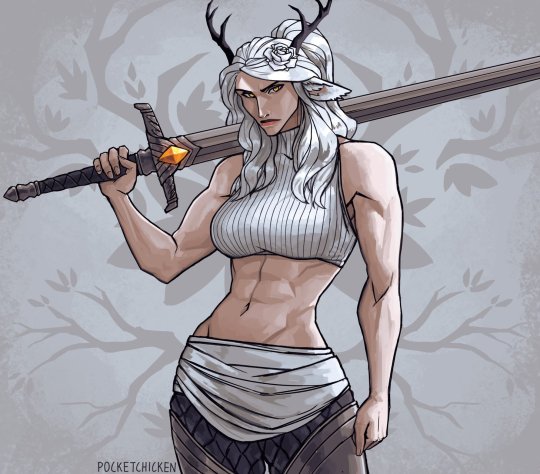
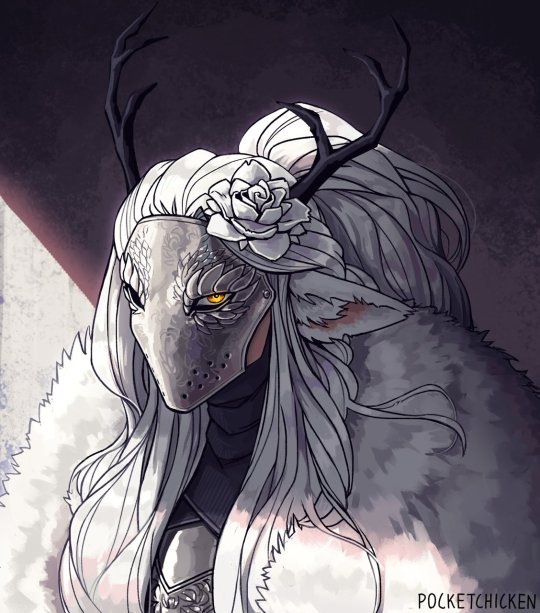

Iron Petal by PocketChicken
4K notes
·
View notes
Text
remember, folks, if you're itching to do something ill-advised in d&d/similar TTRPGs,
low wisdom: poor impulse control
low intelligence: instructions unclear
high wisdom: a necessary risk
high intelligence: it looked better on paper
low wisdom, high intelligence: forgot to get the plan peer-reviewed
high wisdom, low intelligence: the risk i took was calculated, but man am i bad at math
high wisdom, high intelligence: if someone else in the party did it first, it would've gone so much worse (and you Know they were going to do it)
14K notes
·
View notes
Text
Haunted by a fantasy world where "adventurer" is handled in the same way as "assassin" in John Wick. An ifykyk secondary economy running on gold coins where everyone knows each other but no one acknowledges the elephant in the room because we have manners about our weird-ass line of deadly desperate dangerous work.
Rolling into town, looking immaculate. Checking into the Inn. Not an inn, or the coaching house, or the traveler's hostel. The Inn. The one that takes my ridiculous oversized coin and says that my room is ready, and will I need to visit the Smith today? Perhaps a meeting with the Vintner? Shall I send up the Gourmand?
"Good afternoon, Master Whicke," the Smith says, putting aside the barrel scraper he's been working on to flip a switch beside the forge. Racks of tenpenny nails and trowels and hammers fold back to reveal the glittering points and edges of a score of swords and axes and spearpoints lit with the flicker of finely-tuned enchantments. "Shall we tour what's new?"
"What sort of occasion are we hosting, Master Whicke?" The Vintner asks, pocketing the coin with a sigh. "A funeral," you say.
"Ah, well perhaps something light to start, then," she says selecting a straight-walled flask that glitters with contained starlight, proof against the touch of the undead. " And something for remembrance," she plucks a small crock of something evil-smelling and phosphorescent. "And then something to really bring down the house." She gingerly selects a double ampoule of energetic looking jellies.
The Gourmand carefully runs his knife through the salted flank of a cockatrice with a pursing of the lips. "So many neglect trail rations, Master Whicke, and it is their shame. Paired with goldenwheat pancakes and carrion honey, a mouthful of cockatrice--properly seasoned of course--will keep the mummy rot at bay, even post-exposure. I have been given to indicate by the Management that your current escapade may make such information useful to you. I will of course wrap your purchases exceedingly carefully. Rot will be your constant companion in the Black Pyramid."
There's something here.
2K notes
·
View notes
Text

DM Tip: Lining up the Pieces
A few years ago I saw a video that changed the way I design combat encounters, using chess pieces and 4th edition monster roles as a handy way of conceptualizing the enemy roster and making better combat.
I’ve wanted to refer back to it for ages now, but I can’t seem to find it. As such, I’m going to reproduce it’s wisdom here for everyone’s benefit and hope I can find the source one day. ( I feel like it was a Matt Coville video, but my searches have turned up nothing. Seriously, if you can find it I will be extra grateful).
TLDR: You can break down enemy combatants into six (ish) roles represented by different kinds of chess pieces, and you can mix and match them when designing encounter to create fun tactical scenarios. You can also use this as an alternative to CR picking a “budget” of these enemy roles based on how many players are in the fight. Check out the types below the cut:
Keep reading
471 notes
·
View notes